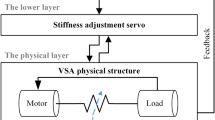Abstract
The response surface method combined with the design of experiment-based design optimization of a variable stiffness joint (VSJ) is presented in this article. A VSJ used in a manipulator of a robot arm to support 1 kg payload at the end is designed by considering the minimization of the total weight as the objective function. Owing to the requirement of large rotational stiffness of the VSJ, over 10 N · m, ring-type permanent magnets are adopted. First, a model composed of two permanent magnets was initially manufactured and tested for comparison with the analysis results. Then, a three-ring-type permanent magnet-based model is suggested and optimized to increase the torque of VSJ. The finite element method is used as a magnetic field analysis method to substitute for the expensive experimental process. Optimization results decrease the weight from 0.899 kg to 0.538 kg, still satisfying the requirement for the rotational stiffness.
Similar content being viewed by others
References
G. Tonietti, R. Schiavim and A. Bicchi, Design and control of a variable stiffness actuator for safe and fast physical human/robot interaction, Proceedings of the IEEE International Conference on Robotics and Automation, Barcelona, Spain, (2002), 79–87.
S. Yun, S. Kang, M. Kim, M. Hyun, J. Yoo and S. Kim, A novel design of high responsive variable stiffness joints for dependable manipulator, Proceedings of ACMD, Tokyo, Japan, (2006), A00695.
D. Akadas and G. A. Merdrano-Cerda, Design of a stabilizing controller for a ten-degree-of-freedom bipedal robot using linear quadratic regulator theory, Proceedings of the Institution of Mechanical Engineers, Part C 215 (2001) 27–43.
J. T. Tarnhuvud and K. Reichert, Accuracy problems of force and torque calculation in FE systems, IEEE Transactions on Magnetics 24(1) (1988) 443–446.
J. Mizia, K. Adamiak, A. R. Eastham and G. E. Dawson, Finite element force calculation: comparison of methods for electric machines, IEEE Transactions on Magnetics 24(1) (1988) 447–450.
J. -H. Lee, S. -J. Park and S.-J Jeon, Optimum design criteria for a synchronous reluctance motor with concentrated winding using response surface methodology, Journal of Applied Physics 99 (2006) 08R325.
Y. Fujishima, S. Wakao, A. Yamashita, T. Katsuta, K. Matsuoka and M. Kondo, Design optimization of a permanent magnet synchronous motor by the response surface methodology, Journal of Applied Physics, 91(10) (2002) 8305–8307.
M. W. Hyun, J. Yoo, S. T. Hwang, J. H. Choi, S. Kang and S.-J. Kim, Optimal design of a variable stiffness joint using permanent magnets, IEEE Transactions on Magnetics 43(6) (2007) 2710–2712.
ANSYS Low-frequency Electromagnetic Analysis Guide, ANSYS, Inc., Canonsburg, PA, (2003).
W. Y. Folkes and C. M. Creveling, Engineering Methods for Robust Product Design, Addison Wesley, Reading, Massachusetts, (1995).
R. H. Meyers and D. C. Montgomery, Response Surface Methodology, Wiley, New York, (1995).
Author information
Authors and Affiliations
Corresponding author
Additional information
This paper was recommended for publication in revised form by Associate Editor Tae Hee Lee
Jeonghoon Yoo received his B.S. and M.S. degrees in Mechanical Design and Production Engineering from Seoul National University, in 1989 and 1991, respectively. He then received his Ph.D. degrees from the University of Michigan, Ann Arbor, in 1999. Dr. Yoo is currently a Professor at the School of Mechanical Engineering at Yonsei University in Seoul, Korea. Dr. Yoo’s research interests include analysis and design of electromagnetic field systems.
Myung Wook Hyun received his B.S. and M.S. degrees in Mechanical Engineering from Yonsei University, Korea, in 1995 and 1997, respectively. While studying for his M.S. degree, Mr. Hyun also studied variable stiffness unit design. He is now working at Samsung Electronics, Co. Ltd..
Jun Ho Choi received his B.S. and M.S. degrees in Mechanical Design from Hanyang University, Korea and his Ph.D. degree from the University of Michigan, Ann Arbor. He is currently a senior research scientist in the Korea Institute of Science and Technology. His research interests include nonlinear control, manipulator control, and safe-joint design.
Sungchul Kang received his B.S., M.S., and Ph.D. degrees in Mechanical Design and Production Engineering from Seoul National University, Korea, in 1989, 1991, and 1998 respectively. Dr. Kang is currently a Principal Research Scientist in the Center for Cognitive Robotics Research, Korea Institute of Science and Technology, in Seoul, Korea. Dr. Kang’s research interests include mobility and manipulation of field and service robots and haptics.
Seung-Jong Kim received his B.S. degree in Mechanical Engineering from Seoul University, Korea, in 1989, and his M.S. and Ph.D. degrees from KAIST in 1991 and 1998, respectively. Dr. Kim is currently a Principal Research Scientist at the Korea Institute of Science and Technology in Seoul, Korea. Dr. Kim’s research interests include the design, control, and dynamic analysis of mechatronic systems.
Rights and permissions
About this article
Cite this article
Yoo, J., Hyun, M.W., Choi, J.H. et al. Optimal design of a variable stiffness joint in a robot manipulator using the response surface method. J Mech Sci Technol 23, 2236–2243 (2009). https://doi.org/10.1007/s12206-009-0516-z
Received:
Revised:
Accepted:
Published:
Issue Date:
DOI: https://doi.org/10.1007/s12206-009-0516-z




